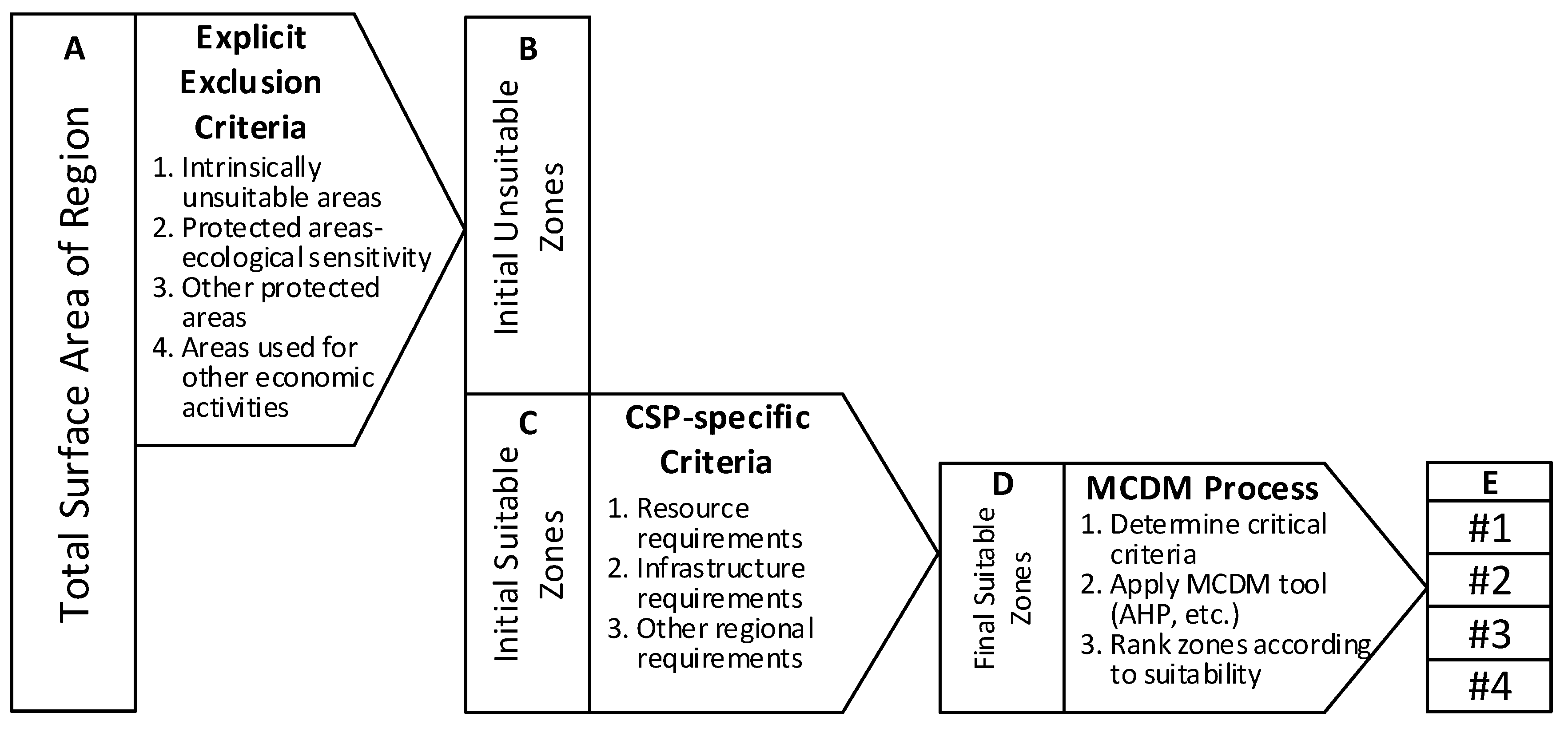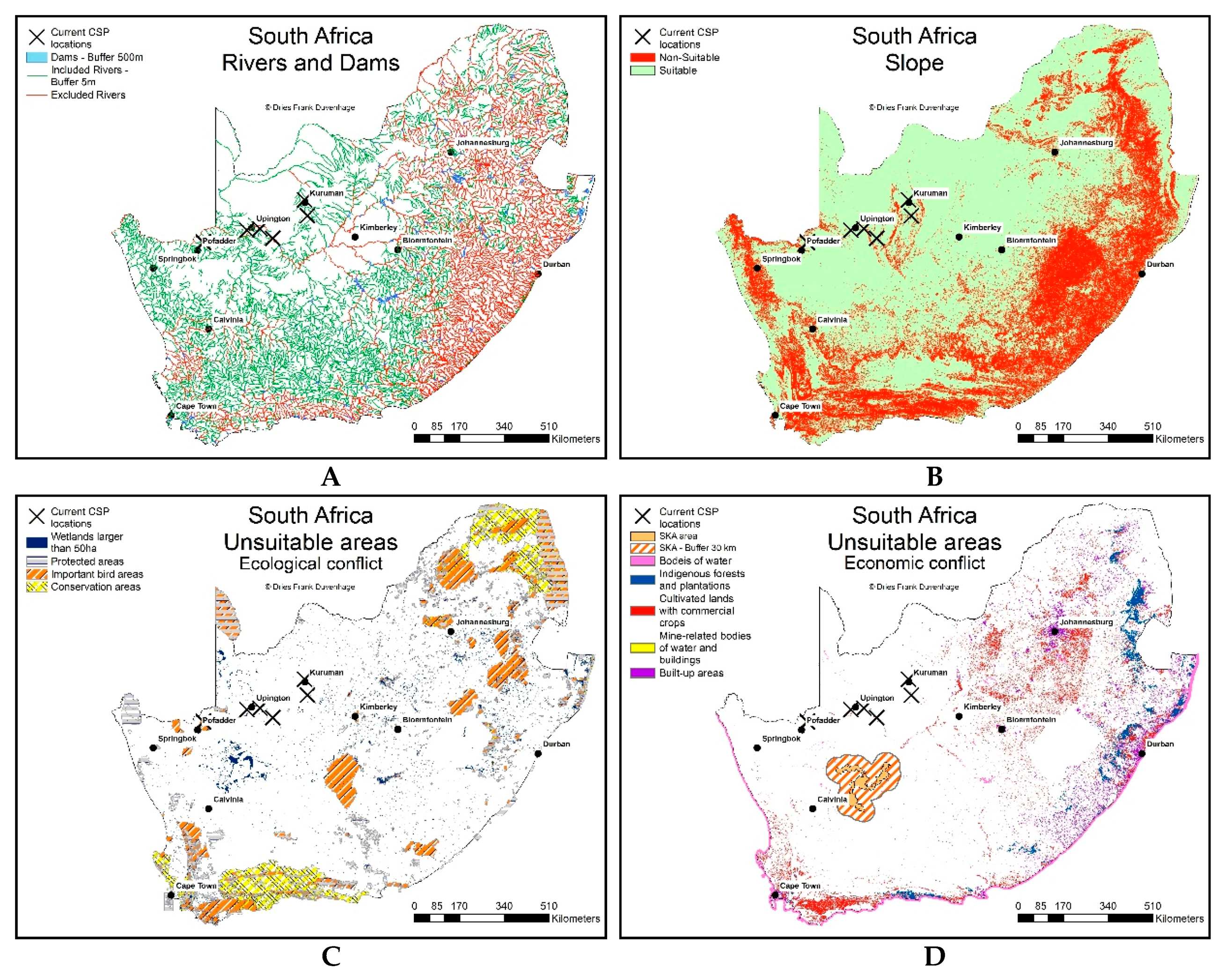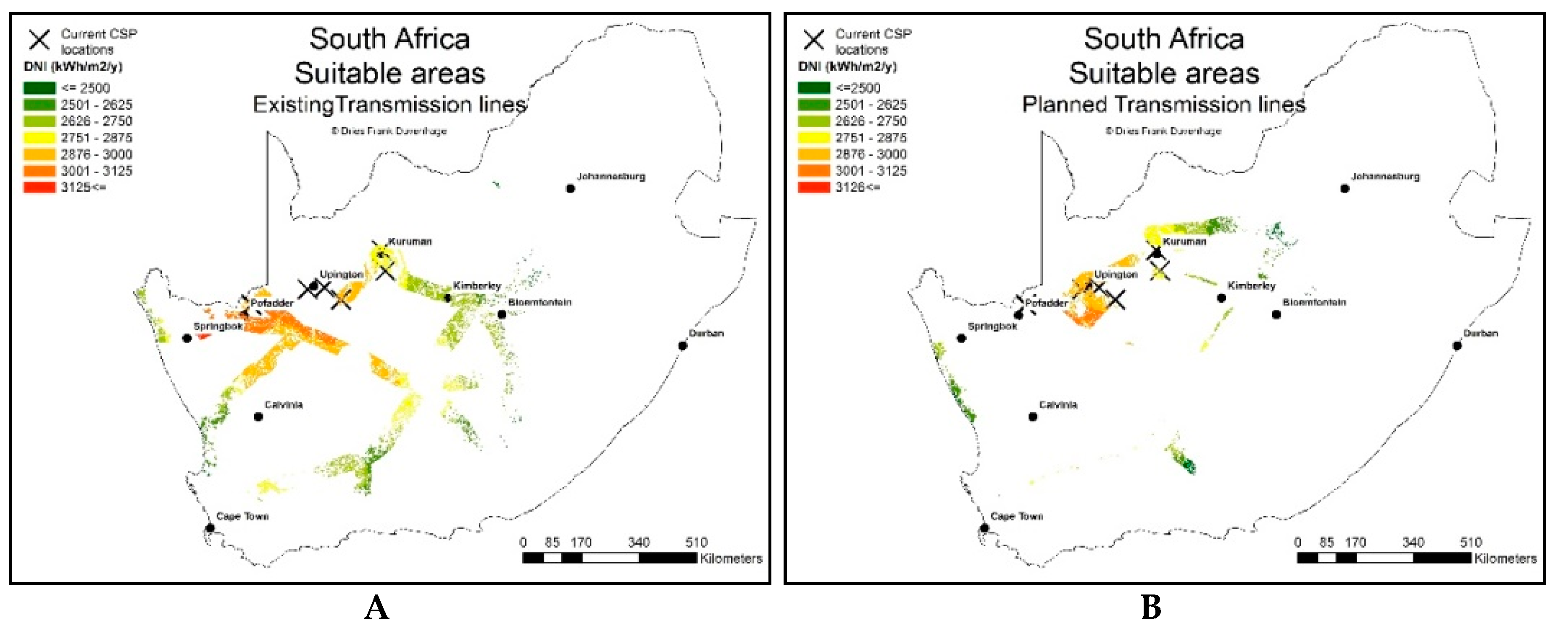Optimising the Concentrating Solar Power Potential in South Africa through an Improved GIS Analysis
Abstract
1. Introduction
2. Materials and Methods
2.1. Exclusion Criteria: Intrinsically Unsuitable Areas
2.2. Exclusion Criteria: Unsuitable Areas due to Ecological Conflict
2.3. Exclusion Criteria: Unsuitable Areas due to Economic Conflict
2.4. CSP-Specific Suitability Criteria: DNI
2.5. CSP-Specific Suitability Criteria: Distance to Required Infrastructure
2.6. Suitability Conditions at Existing CSP Plants in SA
3. Results
CSP Potential Modelling
4. Conclusions
Author Contributions
Funding
Acknowledgments
Conflicts of Interest
References
- IEA. World Energy Outlook 2018; IEA: Paris, France, 2018. Available online: https://www.iea.org/reports/world-energy-outlook-2018 (accessed on 18 March 2019).
- Duvenhage, D.F.; Craig, O.O.; Brent, A.C.; Stafford, W.H.L. Future CSP in South Africa—A review of generation mix models, their assumptions, methods, results and implications. AIP Conf. Proc. 2018, 2033, 120002. [Google Scholar] [CrossRef]
- Duvenhage, D.F.; Brent, A.C.; Stafford, W.H.L. The need to strategically manage CSP fleet development and water resources: A structured review and way forward. Renew. Energy 2019, 132, 813–825. [Google Scholar] [CrossRef]
- Ziuku, S.; Seyitini, L.; Mapurisa, B.; Chikodzi, D.; Van Kuijk, K. Potential of Concentrated Solar Power (CSP) in Zimbabwe. Energy Sustain. Dev. 2014, 23, 220–227. [Google Scholar] [CrossRef]
- Duvenhage, D.F.; Brent, A.C.; Stafford, W.H.L.; Craig, O.O. Water And CSP—A Preliminary Methodology for Strategic Water Demand Assessment. AIP Conf. Proc. 2019, 2126, 220002. [Google Scholar] [CrossRef]
- Ramdé, E.W.; Azoumah, Y.; Brew-Hammond, A.; Rungundu, A.; Tapsoba, G. Site Ranking and Potential Assessment for Concentrating Solar Power in West Africa. Nat. Resour. 2013, 04, 146–153. [Google Scholar] [CrossRef]
- Fluri, T.P. The potential of concentrating solar power in South Africa. Energy Policy 2009, 37, 5075–5080. [Google Scholar] [CrossRef]
- Marnewick, M.; Retief, E.; Theron, N.; Wright, D.; Anderson, T. BirdLife South Africa. Important Bird and Biodiversity Areas of South Africa: Johannesburg, South Africa, 2015. [Google Scholar]
- GEOTERRAIMAGE. 2013–2014 South African National Land Land-Cover Dataset; GEOTERRAIMAGE: Pretoria, South Africa, 2015; Volume 2. [Google Scholar]
- Government Gazette. Regulations On The Protection Of The Karoo Central Astronomy Advantage Areas in Terms Of The Astronomy Geographic Advantage Act, 2007; Government Gazette: Pretoria, South Africa, 2017; pp. 171–226.
- Sengupta, M.; Habte, A.; Kurtz, S.; Dobos, A.; Wilbert, S.; Lorenz, E.; Stoffel, T.; Renné, D.; Gueymard, C.; Myers, D.; et al. Best Practices Handbook for the Collection and Use of Solar Resource Data for Solar Energy Applications; NREL/TP-5D00-63112; NREL: Golden, CO, USA, 2015. [Google Scholar]
- Kearney, A.T. ESTELA Solar Thermal Electricity 2025. Available online: https://www.estelasolar.org/portfolio_page/solar-thermal-electricity-2025/ (accessed on 12 November 2018).
- SolarGIS Solar Resource Maps of South Africa. Available online: https://solargis.com/maps-and-gis-data/download/south-africa (accessed on 22 March 2018).
- Duvenhage, D.F.; Brent, A.C.; Stafford, W.H.L.; Grobbelaar, S. Water and CSP—Linking CSP water demand models and national hydrology data to sustainably manage CSP development and water resources in arid regions. Sustainability 2020, 12, 3373. [Google Scholar] [CrossRef]
- Duvenhage, D.F. Sustainable Future CSP Fleet Deployment in South Africa: A Hydrological Approach to Strategic Management. Ph.D.Thesis, Stellenbosch University, Stellenbosch, South Africa, 2019. Ph.D.Thesis, Stellenbosch University, Stellenbosch, South Africa, 2019. [Google Scholar]
- Statistics South Africa, Electricity Generated and Available for Distribution (Preliminary); Statistics South Africa: Pretoria, South Africa, 2019.
- IPP Office. Independent Power Producers Procurement Programme An Overview December 2018; IPP Office: Pretoria, South Africa, 2018. [Google Scholar]
- Bloomberg New Energy Finance. New Energy Outlook. 2019. Available online: https://about.bnef.com/new-energy-outlook/#toc-download (accessed on 21 January 2020).





| CSP Plant Name | CSP + Cooling Type | Location (Decimal Degrees) | DNI (kWh/m2/y) | Slope (%) | Km to Excl. Water Body | Km to Ecological Conflict Area * | Km to Economic Conflict Area | Km to Tx Liné ** |
|---|---|---|---|---|---|---|---|---|
| Kaxu and Xina | PTDC | −28.89, 19.59 | 2927 | 1.17 | <27 | <1 (IBA) | <26 | <4 (Ex) |
| Khi Solar One | CRDC | −28.54, 28.08 | 2922 | 0.58 | <11 | <12 (wet) | <8 | <4 (Pl) |
| Kathu Solar Park | PTDC | −27.61, 23.04 | 2801 | 0.44 | <50 | <0.5 (wet) | <7 | <9 (Ex) |
| Bokpoort | PTWC | −28.78, 21.96 | 2930 | 2.44 | <2 | <5 (wet) | <5 | <0.4 (Pl) |
| Illanga | PTDC | −28.49, 21.52 | 2912 | 2.44 | <12 | <0.3 (wet) | <11 | <31 (Pl) |
| This study | NA | NA | >2400 | <3.00 | 5 m | NA | NA | <20 |
| Parameter Description | Symbol | Unit | PTWC | PTDC | CRWC | CRDC |
|---|---|---|---|---|---|---|
| Land Use Factor | % | 28 | 28 | 23 | 23 |
| Transmission Line | Area (km2) | PTWC (TWh/y) | PTDC (TWh/y) | CRWC (TWh/y) | CRDC (TWh/y) |
|---|---|---|---|---|---|
| Existing | 71,457 | 7695 | 7532 | 8191 | 8069 |
| Planned | 33,252 | 3581 | 3505 | 3811 | 3754 |
| Total | 104,709 | 11,276 | 11,037 | 12,002 | 11,823 |
| % SA Total * | 8.59% | 4.871% | 4.7% | 5.11% | 5.18% |
© 2020 by the authors. Licensee MDPI, Basel, Switzerland. This article is an open access article distributed under the terms and conditions of the Creative Commons Attribution (CC BY) license (http://creativecommons.org/licenses/by/4.0/).
Share and Cite
Duvenhage, D.F.; Brent, A.C.; Stafford, W.H.L.; Van Den Heever, D. Optimising the Concentrating Solar Power Potential in South Africa through an Improved GIS Analysis. Energies 2020, 13, 3258. https://doi.org/10.3390/en13123258
Duvenhage DF, Brent AC, Stafford WHL, Van Den Heever D. Optimising the Concentrating Solar Power Potential in South Africa through an Improved GIS Analysis. Energies. 2020; 13(12):3258. https://doi.org/10.3390/en13123258
Chicago/Turabian StyleDuvenhage, Dries. Frank, Alan C. Brent, William H.L. Stafford, and Dean Van Den Heever. 2020. "Optimising the Concentrating Solar Power Potential in South Africa through an Improved GIS Analysis" Energies 13, no. 12: 3258. https://doi.org/10.3390/en13123258
APA StyleDuvenhage, D. F., Brent, A. C., Stafford, W. H. L., & Van Den Heever, D. (2020). Optimising the Concentrating Solar Power Potential in South Africa through an Improved GIS Analysis. Energies, 13(12), 3258. https://doi.org/10.3390/en13123258






